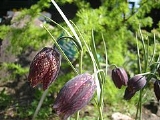
Fritillary
Encyclopedia
Fritillaria is a genus
of about 100 species
of bulb
ous plants in the family Liliaceae
, native to temperate regions of the Northern Hemisphere
. The name is derived from the Latin
term for a dice
-box (fritillus), and probably refers to the checkered pattern, frequently of chocolate-brown and greenish yellow, that is common to many species' flowers. Collectively, the genus is known in English as fritillaries; some North America
n species are called missionbells.
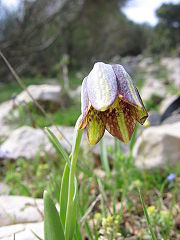 They often have nodding, bell- or cup-shaped flowers, and the majority are spring-flowering. Most species' flowers have a rather disagreeable scent, often referred to as "foxy," like feces
They often have nodding, bell- or cup-shaped flowers, and the majority are spring-flowering. Most species' flowers have a rather disagreeable scent, often referred to as "foxy," like feces
or wet fur
. The Scarlet Lily Beetle
(Lilioceris lilii) eats fritillaries, and may become a pest where these plants are grown in gardens.
Several species (such as F. cirrhosa and F. verticillata
) are used in traditional Chinese cough remedies. They are listed as chuān bèi or zhè bèi (Chinese: 浙貝), respectively, and are often in formulations combined with extracts of Loquat
(Eriobotrya japonica). F. verticillata bulbs are also traded as bèi mǔ or, in Kampō
, baimo (Chinese/Kanji
: 貝母, Katakana
: バイモ). F. thunbergii is contained in the standardized Chinese herbal preparation HealthGuard T18, taken against hyperthyroidism
.
Most fritillaries contain poisonous alkaloid
s such as imperialin; some may even be deadly if ingested in quantity. But the bulb
s of a few species – e.g. Checker Lily (F. affinis) or Yellow Fritillary (F. pudica) – are edible if prepared correctly. They are not generally eaten in large amounts however, and their edibility is therefore still somewhat debatable.
At least one species, F. assyrica, has a very large genome
. With approximately 130,000,000,000 base pair
s, it equals the largest known vertebrate
animal genome known to date – that of the Marbled Lungfish
(Protopterus aethiopicus) – in size.
The emblematic and often unusually-colored fritillaries are commonly used as floral emblem
s. The Snake's Head Fritillary (F. meleagris) is the county
flower of Oxfordshire
(UK
) and the provincial
flower of Uppland
(Sweden
) where it is known as kungsängslilja ("Kungsängen
lily"). In Croatia
this species is known as kockavica, and the checkerboard pattern of its flowers is held to be the inspiration for the šahovnica pattern on Croatia's coat of arms
. The Kamchatka Fritillary (F. camschatcensis) is the floral emblem of Ishikawa Prefecture
and Obihiro city
in Japan
. Its Japanese name is kuroyuri (クロユリ), meaning "dark lily". F. tenella is the floral emblem of Giardino Botanico Alpino di Pietra Corva
, a botanical garden
in Italy
.
Fritillaria is also used as an herb in Traditional Chinese Medicine
, known by the Chinese name Chuan Bei Mu, and latin, Bulbus Fritillariae Cirrhosa. In one study Fritillaria modulated airway inflammation by suppression of cytokines, IgE, histamine production, and eosinophilic accumulation along with increased interferon-gamma production in tests on lung tissue.
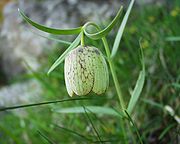
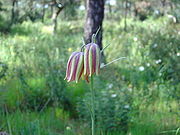

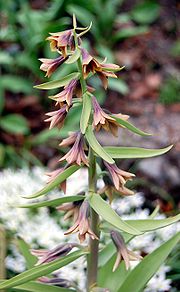
 Formerly placed here:
Formerly placed here:
Genus
In biology, a genus is a low-level taxonomic rank used in the biological classification of living and fossil organisms, which is an example of definition by genus and differentia...
of about 100 species
Species
In biology, a species is one of the basic units of biological classification and a taxonomic rank. A species is often defined as a group of organisms capable of interbreeding and producing fertile offspring. While in many cases this definition is adequate, more precise or differing measures are...
of bulb
Bulb
A bulb is a short stem with fleshy leaves or leaf bases. The leaves often function as food storage organs during dormancy.A bulb's leaf bases, known as scales, generally do not support leaves, but contain food reserves to enable the plant to survive adverse conditions. At the center of the bulb is...
ous plants in the family Liliaceae
Liliaceae
The Liliaceae, or the lily family, is a family of monocotyledons in the order Liliales. Plants in this family have linear leaves, mostly with parallel veins but with several having net venation , and flower arranged in threes. Several have bulbs, while others have rhizomes...
, native to temperate regions of the Northern Hemisphere
Northern Hemisphere
The Northern Hemisphere is the half of a planet that is north of its equator—the word hemisphere literally means “half sphere”. It is also that half of the celestial sphere north of the celestial equator...
. The name is derived from the Latin
Latin
Latin is an Italic language originally spoken in Latium and Ancient Rome. It, along with most European languages, is a descendant of the ancient Proto-Indo-European language. Although it is considered a dead language, a number of scholars and members of the Christian clergy speak it fluently, and...
term for a dice
Dice
A die is a small throwable object with multiple resting positions, used for generating random numbers...
-box (fritillus), and probably refers to the checkered pattern, frequently of chocolate-brown and greenish yellow, that is common to many species' flowers. Collectively, the genus is known in English as fritillaries; some North America
North America
North America is a continent wholly within the Northern Hemisphere and almost wholly within the Western Hemisphere. It is also considered a northern subcontinent of the Americas...
n species are called missionbells.
Description and uses

Feces
Feces, faeces, or fæces is a waste product from an animal's digestive tract expelled through the anus or cloaca during defecation.-Etymology:...
or wet fur
Fur
Fur is a synonym for hair, used more in reference to non-human animals, usually mammals; particularly those with extensives body hair coverage. The term is sometimes used to refer to the body hair of an animal as a complete coat, also known as the "pelage". Fur is also used to refer to animal...
. The Scarlet Lily Beetle
Scarlet lily beetle
The scarlet lily beetle , or red / leaf lily beetle, is a leaf beetle that eats the leaves, stem, buds and flower of lilies, fritillaries and other members of the family Liliaceae. They mainly lay their eggs on Lilium and Fritillaria species...
(Lilioceris lilii) eats fritillaries, and may become a pest where these plants are grown in gardens.
Several species (such as F. cirrhosa and F. verticillata
Fritillaria verticillata
Fritillaria verticillata is a plant belonging to the genus Fritillaria and native to Central Asia.Fritillaria verticillata can grow to 60 cm tall. It has white flowers with some green, and it flowers in spring....
) are used in traditional Chinese cough remedies. They are listed as chuān bèi or zhè bèi (Chinese: 浙貝), respectively, and are often in formulations combined with extracts of Loquat
Loquat
The loquat , Eriobotrya japonica, is a fruit tree in the family Rosaceae, indigenous to southeastern China. It was formerly thought to be closely related to the genus Mespilus, and is still sometimes known as the Japanese medlar...
(Eriobotrya japonica). F. verticillata bulbs are also traded as bèi mǔ or, in Kampō
Kampo
, alternatively shortened as just , is the Japanese study and adaptation of Traditional Chinese medicine. The basic works of Chinese medicine came to Japan between the 7th and 9th centuries. Since then, the Japanese have created their own unique herbal medical system and diagnosis...
, baimo (Chinese/Kanji
Kanji
Kanji are the adopted logographic Chinese characters hanzi that are used in the modern Japanese writing system along with hiragana , katakana , Indo Arabic numerals, and the occasional use of the Latin alphabet...
: 貝母, Katakana
Katakana
is a Japanese syllabary, one component of the Japanese writing system along with hiragana, kanji, and in some cases the Latin alphabet . The word katakana means "fragmentary kana", as the katakana scripts are derived from components of more complex kanji. Each kana represents one mora...
: バイモ). F. thunbergii is contained in the standardized Chinese herbal preparation HealthGuard T18, taken against hyperthyroidism
Hyperthyroidism
Hyperthyroidism is the term for overactive tissue within the thyroid gland causing an overproduction of thyroid hormones . Hyperthyroidism is thus a cause of thyrotoxicosis, the clinical condition of increased thyroid hormones in the blood. Hyperthyroidism and thyrotoxicosis are not synonymous...
.
Most fritillaries contain poisonous alkaloid
Alkaloid
Alkaloids are a group of naturally occurring chemical compounds that contain mostly basic nitrogen atoms. This group also includes some related compounds with neutral and even weakly acidic properties. Also some synthetic compounds of similar structure are attributed to alkaloids...
s such as imperialin; some may even be deadly if ingested in quantity. But the bulb
Bulb
A bulb is a short stem with fleshy leaves or leaf bases. The leaves often function as food storage organs during dormancy.A bulb's leaf bases, known as scales, generally do not support leaves, but contain food reserves to enable the plant to survive adverse conditions. At the center of the bulb is...
s of a few species – e.g. Checker Lily (F. affinis) or Yellow Fritillary (F. pudica) – are edible if prepared correctly. They are not generally eaten in large amounts however, and their edibility is therefore still somewhat debatable.
At least one species, F. assyrica, has a very large genome
Genome
In modern molecular biology and genetics, the genome is the entirety of an organism's hereditary information. It is encoded either in DNA or, for many types of virus, in RNA. The genome includes both the genes and the non-coding sequences of the DNA/RNA....
. With approximately 130,000,000,000 base pair
Base pair
In molecular biology and genetics, the linking between two nitrogenous bases on opposite complementary DNA or certain types of RNA strands that are connected via hydrogen bonds is called a base pair...
s, it equals the largest known vertebrate
Vertebrate
Vertebrates are animals that are members of the subphylum Vertebrata . Vertebrates are the largest group of chordates, with currently about 58,000 species described. Vertebrates include the jawless fishes, bony fishes, sharks and rays, amphibians, reptiles, mammals, and birds...
animal genome known to date – that of the Marbled Lungfish
Marbled Lungfish
The marbled lungfish, Protopterus aethiopicus, is a lungfish of the family Protopteridae. Also known as the leopard lungfish, it is found in Africa...
(Protopterus aethiopicus) – in size.
The emblematic and often unusually-colored fritillaries are commonly used as floral emblem
Floral emblem
In a number of countries, plants have been chosen as symbols to represent specific geographic areas. Some countries have a country-wide floral emblem; others in addition have symbols representing subdivisions. Different processes have been used to adopt these symbols - some are conferred by...
s. The Snake's Head Fritillary (F. meleagris) is the county
Counties of England
Counties of England are areas used for the purposes of administrative, geographical and political demarcation. For administrative purposes, England outside Greater London and the Isles of Scilly is divided into 83 counties. The counties may consist of a single district or be divided into several...
flower of Oxfordshire
Oxfordshire
Oxfordshire is a county in the South East region of England, bordering on Warwickshire and Northamptonshire , Buckinghamshire , Berkshire , Wiltshire and Gloucestershire ....
(UK
United Kingdom
The United Kingdom of Great Britain and Northern IrelandIn the United Kingdom and Dependencies, other languages have been officially recognised as legitimate autochthonous languages under the European Charter for Regional or Minority Languages...
) and the provincial
Provinces of Sweden
The provinces of Sweden, landskap, are historical, geographical and cultural regions. Sweden has 25 provinces and they have no administrative function, but remain historical legacies and the means of cultural identification....
flower of Uppland
Uppland
Uppland is a historical province or landskap on the eastern coast of Sweden, just north of Stockholm, the capital. It borders Södermanland, Västmanland and Gästrikland. It is also bounded by lake Mälaren and the Baltic sea...
(Sweden
Sweden
Sweden , officially the Kingdom of Sweden , is a Nordic country on the Scandinavian Peninsula in Northern Europe. Sweden borders with Norway and Finland and is connected to Denmark by a bridge-tunnel across the Öresund....
) where it is known as kungsängslilja ("Kungsängen
Kungsängen
Kungsängen is a locality and the seat of Upplands-Bro Municipality, Stockholm County, Sweden with 7,367 inhabitants in 2005.- References :...
lily"). In Croatia
Croatia
Croatia , officially the Republic of Croatia , is a unitary democratic parliamentary republic in Europe at the crossroads of the Mitteleuropa, the Balkans, and the Mediterranean. Its capital and largest city is Zagreb. The country is divided into 20 counties and the city of Zagreb. Croatia covers ...
this species is known as kockavica, and the checkerboard pattern of its flowers is held to be the inspiration for the šahovnica pattern on Croatia's coat of arms
Coat of arms of Croatia
The coat of arms of Croatia consists of one main shield and five smaller shields which form a crown over the main shield. The main coat of arms is a checkerboard that consists of 13 red and 12 silver fields. It's commonly known as šahovnica or grb...
. The Kamchatka Fritillary (F. camschatcensis) is the floral emblem of Ishikawa Prefecture
Ishikawa Prefecture
is a prefecture of Japan located in the Chūbu region on Honshū island. The capital is Kanazawa.- History :Ishikawa was formed from the merger of Kaga Province and the smaller Noto Province.- Geography :Ishikawa is on the Sea of Japan coast...
and Obihiro city
Obihiro, Hokkaido
is a city located in Tokachi, Hokkaidō, Japan. Obihiro is the only city in the Tokachi area. The next most populous municipality in Tokachi is the town of Otofuke, with less than a third of Obihiro's population. The city has approximately 500 foreign residents . The city contains the headquarters...
in Japan
Japan
Japan is an island nation in East Asia. Located in the Pacific Ocean, it lies to the east of the Sea of Japan, China, North Korea, South Korea and Russia, stretching from the Sea of Okhotsk in the north to the East China Sea and Taiwan in the south...
. Its Japanese name is kuroyuri (クロユリ), meaning "dark lily". F. tenella is the floral emblem of Giardino Botanico Alpino di Pietra Corva
Giardino Botanico Alpino di Pietra Corva
The Giardino Botanico Alpino di Pietra Corva is a botanical garden located at 950 meters elevation on the side of Pietra di Corvo mountain, just east of Romagnese, Province of Pavia, Lombardy, Italy...
, a botanical garden
Botanical garden
A botanical garden The terms botanic and botanical, and garden or gardens are used more-or-less interchangeably, although the word botanic is generally reserved for the earlier, more traditional gardens. is a well-tended area displaying a wide range of plants labelled with their botanical names...
in Italy
Italy
Italy , officially the Italian Republic languages]] under the European Charter for Regional or Minority Languages. In each of these, Italy's official name is as follows:;;;;;;;;), is a unitary parliamentary republic in South-Central Europe. To the north it borders France, Switzerland, Austria and...
.
Fritillaria is also used as an herb in Traditional Chinese Medicine
Traditional Chinese medicine
Traditional Chinese Medicine refers to a broad range of medicine practices sharing common theoretical concepts which have been developed in China and are based on a tradition of more than 2,000 years, including various forms of herbal medicine, acupuncture, massage , exercise , and dietary therapy...
, known by the Chinese name Chuan Bei Mu, and latin, Bulbus Fritillariae Cirrhosa. In one study Fritillaria modulated airway inflammation by suppression of cytokines, IgE, histamine production, and eosinophilic accumulation along with increased interferon-gamma production in tests on lung tissue.
Selected species





- Erythronium multiscapoideumErythronium multiscapoideumErythronium multiscapoideum is a species of flowering plant in the lily family which is known by the common name Sierra fawn lily.It is endemic to California, where it grows in the foothills of the southern Cascade Range and the Sierra Nevada....
(as F. multiscapoidea)

